-
 Bitcoin
Bitcoin $116400
-1.69% -
 Ethereum
Ethereum $3731
2.87% -
 XRP
XRP $3.119
-1.00% -
 Tether USDt
Tether USDt $1.000
-0.04% -
 BNB
BNB $774.0
1.01% -
 Solana
Solana $181.0
-2.25% -
 USDC
USDC $1.000
0.02% -
 Dogecoin
Dogecoin $0.2314
-2.16% -
 TRON
TRON $0.3145
1.76% -
 Cardano
Cardano $0.8087
0.22% -
 Hyperliquid
Hyperliquid $43.01
0.68% -
 Stellar
Stellar $0.4247
-0.93% -
 Sui
Sui $3.758
1.42% -
 Chainlink
Chainlink $18.30
1.99% -
 Bitcoin Cash
Bitcoin Cash $551.4
5.66% -
 Hedera
Hedera $0.2482
3.08% -
 Avalanche
Avalanche $23.70
0.18% -
 Litecoin
Litecoin $115.1
2.44% -
 UNUS SED LEO
UNUS SED LEO $8.972
-0.36% -
 Shiba Inu
Shiba Inu $0.00001370
0.73% -
 Toncoin
Toncoin $3.146
0.74% -
 Ethena USDe
Ethena USDe $1.001
-0.03% -
 Uniswap
Uniswap $10.49
3.95% -
 Polkadot
Polkadot $4.044
1.42% -
 Monero
Monero $328.9
2.43% -
 Dai
Dai $0.9998
-0.03% -
 Bitget Token
Bitget Token $4.510
-1.10% -
 Pepe
Pepe $0.00001231
-1.68% -
 Aave
Aave $293.4
2.16% -
 Cronos
Cronos $0.1294
2.89%
How to grasp the trading opportunity of 4-hour moving average adhesion + 30-minute MACD zero axis golden cross?
The 4-hour moving average adhesion signals consolidation, while a 30-minute MACD golden cross near zero confirms bullish momentum for timely crypto entries.
Jul 24, 2025 at 05:07 am
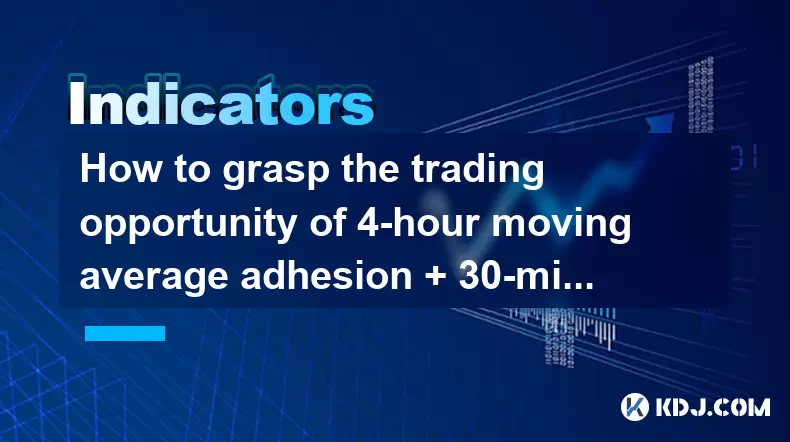
Understanding the 4-Hour Moving Average Adhesion
In cryptocurrency trading, the 4-hour moving average adhesion is a powerful technical signal indicating consolidation among multiple moving averages on the 4-hour chart. This phenomenon occurs when several key moving averages—such as the 20-period, 50-period, and 100-period simple moving averages (SMA) or exponential moving averages (EMA)—converge closely together. When this adhesion happens, it reflects a period of market indecision or balance between buyers and sellers. The tighter the clustering of these moving averages, the stronger the potential breakout once price begins to move decisively.
Traders interpret this adhesion as a compression phase, where volatility is low and the market is preparing for a directional move. The key is to monitor the price action as it approaches or begins to break away from this cluster. A break above the adhesion zone suggests bullish momentum may be building, while a break below indicates bearish pressure. However, confirmation from lower timeframes is essential before entering a trade.
To identify this setup, open your trading platform and load the 4-hour chart of the cryptocurrency pair you are analyzing. Apply the following moving averages: EMA(20), EMA(50), and EMA(100). Observe whether these lines are converging into a narrow band. If they are overlapping or nearly overlapping, the adhesion condition is met. This visual tightness is the first half of the strategy.
Interpreting the 30-Minute MACD Zero Axis Golden Cross
The second component of this trading opportunity involves the 30-minute MACD (Moving Average Convergence Divergence) zero axis golden cross. The MACD consists of three elements: the MACD line, the signal line, and the histogram. A golden cross on the MACD occurs when the MACD line crosses above the signal line, but the critical factor here is that this crossover must happen at or very near the zero axis.
The zero axis represents the equilibrium point of momentum. A crossover above zero indicates that bullish momentum is not only emerging but is strong enough to shift the balance from neutral to positive. This is more significant than a crossover occurring deep in negative territory, which might reflect a weak bounce rather than a sustainable trend.
To set up the MACD on the 30-minute chart, ensure the standard settings are used: (12, 26, 9). Watch for the moment the MACD line (the faster line) rises above the signal line (the slower line) while both are close to the zero line. The histogram should transition from negative to positive, confirming the shift in momentum. This signal acts as a timely trigger for entry when combined with the 4-hour adhesion setup.
It is crucial that the MACD crossover occurs after the price has already broken out of the 4-hour moving average adhesion zone. This sequence ensures alignment between higher timeframe structure and lower timeframe momentum.
Entry Strategy and Confirmation Steps
Executing a trade based on this dual-timeframe strategy requires precise timing and confirmation. Once the 4-hour adhesion is identified and the price begins to break out, shift attention to the 30-minute chart for the MACD signal.
- Monitor the 4-hour chart for a clear close above the moving average cluster for a long setup (or below for a short, though this strategy focuses on bullish entries).
- Switch to the 30-minute chart and wait for the MACD line to cross above the signal line near the zero axis.
- Confirm that the MACD histogram is turning positive and expanding.
- Ensure that the 30-minute candle is still forming or has just closed, validating the crossover.
Do not enter before the 30-minute candle completes. Premature entries often lead to false signals. Use a market or limit order depending on your broker’s execution speed. For example, if the crossover occurs on a candle that closes at $30,000, place your entry at the open of the next candle or slightly above the high of the signal candle to ensure confirmation.
Setting Stop-Loss and Take-Profit Levels
Risk management is vital in this strategy. The stop-loss should be placed below the recent swing low on the 30-minute chart or, more conservatively, below the 4-hour moving average adhesion zone. This protects against a false breakout.
- For a long trade, place the stop-loss 1% to 2% below the entry candle’s low on the 30-minute chart.
- Alternatively, use the lowest point of the 4-hour adhesion cluster as a structural stop-loss level.
- Set the take-profit at a 2:1 or 3:1 risk-reward ratio. For instance, if your risk is $100, aim for a $200–$300 gain.
- Consider scaling out: take 50% off at 1:1, then move stop-loss to break-even, and let the rest run toward 2:1 or 3:1.
Use Fibonacci extensions from the recent swing low to swing high within the breakout move to identify logical resistance zones for profit targets. Avoid arbitrary price levels.
Example Scenario Using BTC/USDT
Suppose BTC/USDT has been trading sideways on the 4-hour chart. The EMA(20), EMA(50), and EMA(100) are all within a $500 range around $28,000, forming a tight adhesion. On the 30-minute chart, price begins to rise, breaking above $28,500 with strong volume. Shortly after, the MACD line crosses above the signal line at the zero axis. The histogram turns green and begins to expand.
- Entry: $28,550, at the close of the 30-minute candle confirming the MACD crossover.
- Stop-loss: $28,200, just below the 4-hour adhesion zone.
- Take-profit 1: $29,100 (1:1).
- Take-profit 2: $29,650 (2:1).
This setup leverages confluence: higher timeframe consolidation, breakout confirmation, and lower timeframe momentum alignment.
Common Mistakes to Avoid
Traders often misapply this strategy by ignoring timeframe alignment. A MACD crossover on the 30-minute chart that occurs before the 4-hour breakout is invalid. Patience is required. Another error is using non-standard MACD settings, which can distort the zero-axis significance. Always use (12, 26, 9) unless backtesting proves otherwise.
Avoid trading during low-volume periods such as weekends or major news events, as false breakouts are more common. Also, do not ignore volume confirmation—rising volume on the breakout candle strengthens the signal.
FAQs
What if the MACD crossover happens far from the zero axis?
A crossover deep in negative territory lacks strength. It may indicate a minor bounce, not a sustainable trend. Only crossovers near or at the zero line are considered valid for this strategy.
Can this strategy be used for short trades?
Yes, but the conditions reverse: look for a break below the 4-hour moving average adhesion and a MACD death cross near zero on the 30-minute chart. However, shorting in crypto carries higher risk due to volatility and pump dynamics.
How do I know the moving averages are truly "adhered"?
The EMAs should be within 1%–2% of each other relative to the asset’s price. For Bitcoin at $30,000, a $300–$600 range is acceptable. Visual clustering on the chart is a reliable indicator.
Should I use EMA or SMA for the moving averages?
Use EMA (Exponential Moving Average) because it reacts faster to recent price changes, making adhesion more responsive and timely for breakout detection.
Disclaimer:info@kdj.com
The information provided is not trading advice. kdj.com does not assume any responsibility for any investments made based on the information provided in this article. Cryptocurrencies are highly volatile and it is highly recommended that you invest with caution after thorough research!
If you believe that the content used on this website infringes your copyright, please contact us immediately (info@kdj.com) and we will delete it promptly.
- Pump, Bonk, Buyback: A Wild Ride in Crypto Town!
- 2025-07-25 19:10:12
- Punisher Coin, Dogecoin, Shiba Inu: Meme Coin Mania in the 2025 Crypto Landscape
- 2025-07-25 19:10:12
- Celestia's Token Control: Buyback & Staking Overhaul in Focus
- 2025-07-25 19:50:11
- Altcoins, Bitcoin, and Crypto Coins: What's Hot in the NYC Crypto Scene?
- 2025-07-25 19:55:52
- Litecoin Price Breakout Imminent? Rally Potential Explored!
- 2025-07-25 17:30:12
- Ether ETFs Surge, Bitcoin Wobbles: Is an ETH Breakout Imminent?
- 2025-07-25 16:50:12
Related knowledge

How to interpret that the KDJ D line is downward for a long time but the price is sideways?
Jul 25,2025 at 07:00pm
Understanding the KDJ Indicator and Its ComponentsThe KDJ indicator is a momentum oscillator widely used in cryptocurrency trading to assess overbough...

What does it mean that the KDJ indicator forms a double bottom at a low level?
Jul 25,2025 at 05:08pm
Understanding the KDJ Indicator in Cryptocurrency TradingThe KDJ indicator is a momentum oscillator widely used in cryptocurrency trading to identify ...
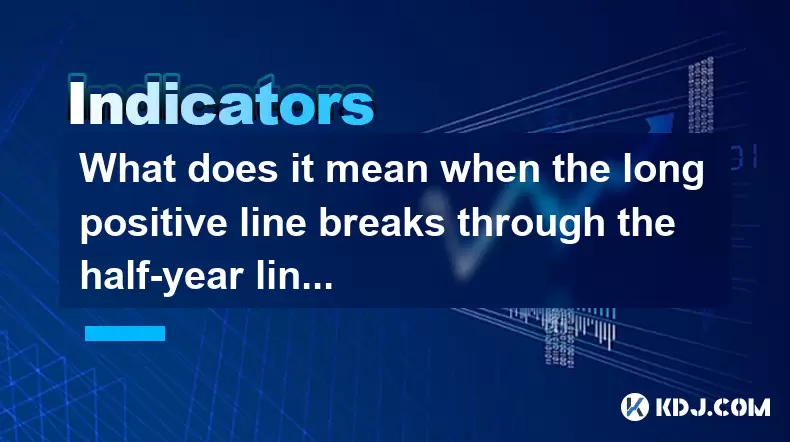
What does it mean when the long positive line breaks through the half-year line and then steps back?
Jul 25,2025 at 06:49pm
Understanding the Long Positive Line in Candlestick ChartsIn the world of cryptocurrency trading, candlestick patterns play a vital role in technical ...
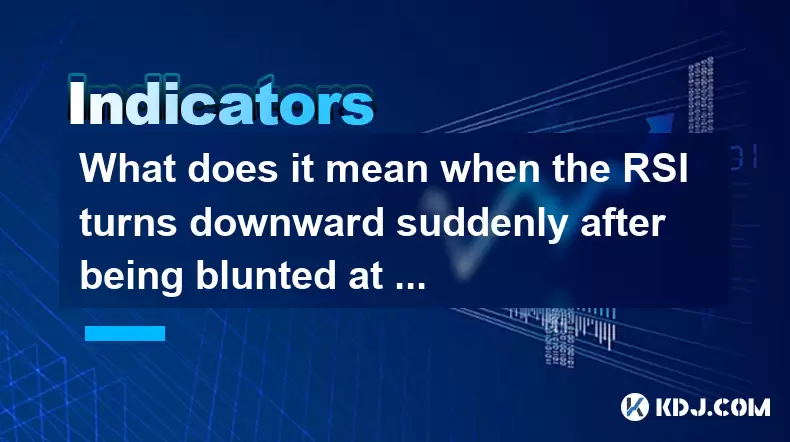
What does it mean when the RSI turns downward suddenly after being blunted at a high level?
Jul 25,2025 at 04:00pm
Understanding the RSI and Its Role in Technical AnalysisThe Relative Strength Index (RSI) is a momentum oscillator that measures the speed and change ...
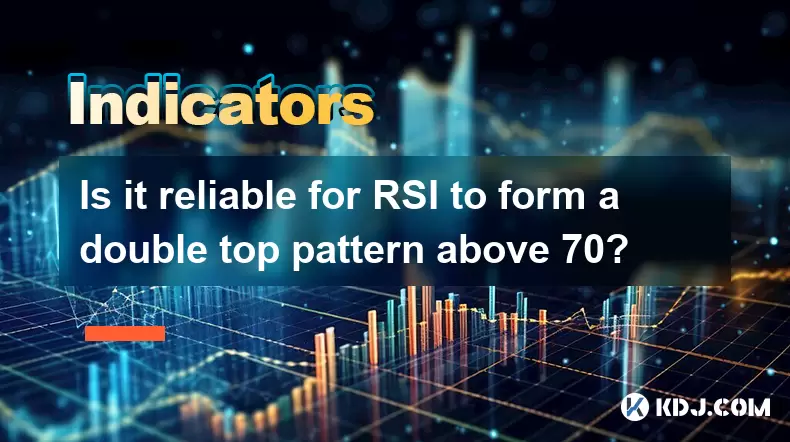
Is it reliable for RSI to form a double top pattern above 70?
Jul 25,2025 at 04:49pm
Understanding the RSI Indicator and Its Role in Technical AnalysisThe Relative Strength Index (RSI) is a momentum oscillator that measures the speed a...
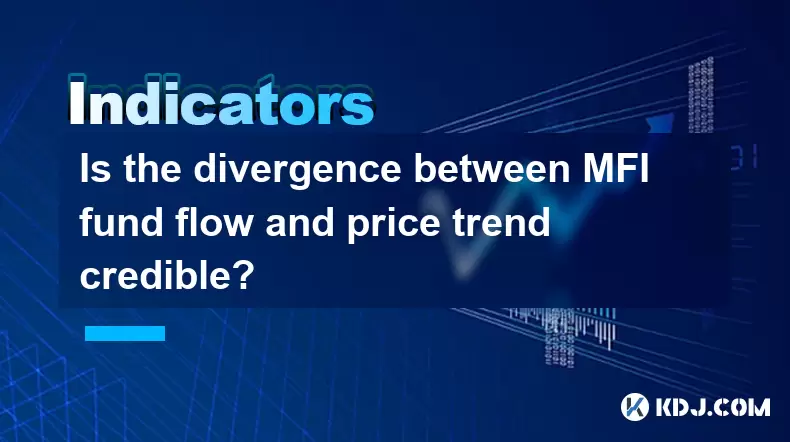
Is the divergence between MFI fund flow and price trend credible?
Jul 25,2025 at 12:01pm
Understanding MFI and Fund Flow in Cryptocurrency MarketsThe Money Flow Index (MFI) is a technical oscillator that combines price and volume to assess...

How to interpret that the KDJ D line is downward for a long time but the price is sideways?
Jul 25,2025 at 07:00pm
Understanding the KDJ Indicator and Its ComponentsThe KDJ indicator is a momentum oscillator widely used in cryptocurrency trading to assess overbough...

What does it mean that the KDJ indicator forms a double bottom at a low level?
Jul 25,2025 at 05:08pm
Understanding the KDJ Indicator in Cryptocurrency TradingThe KDJ indicator is a momentum oscillator widely used in cryptocurrency trading to identify ...

What does it mean when the long positive line breaks through the half-year line and then steps back?
Jul 25,2025 at 06:49pm
Understanding the Long Positive Line in Candlestick ChartsIn the world of cryptocurrency trading, candlestick patterns play a vital role in technical ...

What does it mean when the RSI turns downward suddenly after being blunted at a high level?
Jul 25,2025 at 04:00pm
Understanding the RSI and Its Role in Technical AnalysisThe Relative Strength Index (RSI) is a momentum oscillator that measures the speed and change ...

Is it reliable for RSI to form a double top pattern above 70?
Jul 25,2025 at 04:49pm
Understanding the RSI Indicator and Its Role in Technical AnalysisThe Relative Strength Index (RSI) is a momentum oscillator that measures the speed a...

Is the divergence between MFI fund flow and price trend credible?
Jul 25,2025 at 12:01pm
Understanding MFI and Fund Flow in Cryptocurrency MarketsThe Money Flow Index (MFI) is a technical oscillator that combines price and volume to assess...
See all articles

























































































